In the midst of an epic budget battle, the White House and Republicans in Congress appear to agree on one point: Federal prisons need more money.
With more people and a higher percentage of the population locked up than any other country, the United States would seem more than ripe for cuts in both its incarceration rate and its prison spending. A number of states have initiated such measures, and a growing chorus of critics on the right and left are decrying the devastating costs–fiscal and otherwise–of mass incarceration. Yet the Obama Administration’s combined budget requests for FY 2011 and FY 2012 call for a full 10 percent increase over 2010 levels in funding to the federal Bureau of Prisons, to more than $6.8 billion. The increase, says the BOP, is necessary to accommodate a still-growing federal inmate population. And the latest budget deal reached with Republican leadership indicates that this particular category of discretionary spending will emerge from the budget battles comparably unscathed.
There is ample precedent for an expansion of federal prisons under a Democratic administration. According to analyses by the Sentencing Project and the Pew Center on the States, the growth rate in the BOP’s population has far outstripped that of the states (which itself has increased by than 700 percent in the past 40 years). Federal growth was most dramatic during the Clinton years, when a host of new offenses were federalized: Since 1995 alone, the number of federal inmates has more than doubled, to over 211,000. More than half of these prisoners are serving time on drug charges, and another 10 percent are held on immigration violations. In all, more than 72 percent are nonviolent offenders with no history of violence, and 34 percent are first-time nonviolent offenders.
What’s more, the federal government is now bucking a state trend toward decreasing inmate levels and closing prisons. The Pew Center found that in 2009, in the wake of the financial crisis, the overall state prison population fell for the first time in 38 years. States as tough on crime as Texas, Georgia, and Florida are now pushing reforms that range from lighter sentences to early release programs—all under the leadership of Republican governors. In contrast, the BOP population continues to rise, with an increase of 11,000 projected this year, according to Attorney General Eric Holder.
No wonder, then, that federal prisons are overcrowded, and the government is still opening new ones. According to the Justice Department’s FY 2012 budget request for the Bureau of Prisons:
The biggest challenge facing the BOP is managing the ever increasing federal inmate population and providing for their care and safety, while maintaining appropriately safe and secure prisons required to ensure the safety of BOP staff, inmates, and surrounding communities, which is why the requested base resources for BOP’s operations budget (S&E) and for modernization and repair are vital.
BOP anticipates finalizing the construction of Federal Correctional Center (FCI) Aliceville, AL, a secure female facility in FY 2012. This facility will add 1,792 more beds to rated capacity. Assuming the requested FY 2012 funding is received, the BOP will begin the activation process of FCI Berlin, NH and the acquisition and renovation process of administrative maximum U.S. Penitentiary (ADX USP) Thomson, IL. If realized, FCI Berlin, NH will add 1,280 beds and ADX USP Thomson, IL will be activated as a federal institution and add up to 1,600 high security cells after modifications.
The “activation” of the new ADX (“administrative maximum”) prison in 2012 depends upon the purchase of that prison in 2011 from the state of Illinois, and its retrofitting as a federal supermax. This has been by far the most controversial facet of the BOP’s future plans, since the new ADX in Thomson was originally proposed as a new home for Guantanamo detainees.
Obama’s plans to close Gitmo and move its residents to the American mainland were stymied by Congress, but the White House decided to buy Thomson nonetheless. In a letter sent just last week, Eric Holder assured Illinois’s Democratic Senator Dick Durban and Republican Senator Mark Kirk that “consistent with current law, we will not transfer detainees from Guantanamo to Thomson, or otherwise house Guantanamo detainees at Thomson. The Thomson facility would only house federal inmates and would be operated solely by the Bureau of Prisons.”
What the White House is calling for, then, is the creation of a second federal supermax on the model of the notorious Florence ADX in Colorado—a place where solitary confinement has been raised to a torturous art, and inmates seldom see another human being. Conditions at this “Alcatraz of the Rockies” are so harsh that the European Court of Human Rights is currently refusing to extradite terrorism suspects to the United States lest they end up in ADX. Yet this new prison has also become the centerpiece of Obama’s plans for prison expansion. The letter from Holder to Durbin and Kirk continues:
As you know, the Department wishes to acquire the Thomson facility in order to provide critically needed high security bed space for the federal Bureau of Prisons. The current population of high security federal penitentiaries is 51% above rated capacity, and continues to grow…I appreciate your leadership in addressing the dangers of prison overcrowding, and in fostering community support for the federal government’s acquisition of this unused state facility.
The President’s FY11 budget requested $237 million for the acquisition, renovation, and operation of the Thomson facility. However, under the FY11 Continuing Resolutions, the Department lacks sufficient money to purchase or activate Thomson using currently available funds. We look forward to working with you to obtain additional appropriated funds for this important and needed project.
So far, this new prison remains a sticking point in the latest budget deal. With $6.3 billion for the BOP, the new budget includes much of the other prison funding requested by the White House, and represents a significant increase over 2010 levels. But it is still $239 billion below the White House’s 2011 request, and doesn’t contain funding for the Thomson purchase. Durbin and Kirk have not given up on the plan, however, and will continue pressing the Justice Department to come up with funds to finance the new prison.
The BOP’s standing in the House Republicans’ 2012 budget proposal is less clear. Budget Chair Paul Ryan’s “Path to Prosperity” calls for more than $10 billion in cuts to programs that fall under the broad spending category “Administration of Justice.” But the plan, which is more of a manifesto than an actual budget, doesn’t specify where these cuts should be made. History would suggest that civil rights prosecutions and the like would be more obvious targets for Republican cuts than prison spending, but it’s still too soon to tell. In another rare show of bipartisan unity, House Judiciary Committee Chair Lamar Smith (R-TX) and ranking member John Conyers (D-MI) have already joined in writing to the House Budget Committee, warning them against making cuts to federal law enforcement in 2012.
What belies all this agreement on increasing federal prison spending is a bipartisan trend, growing over the past several months, that calls for precisely the opposite. Fall 2010 saw the birth of the group Right on Crime, spearheaded by the likes of Newt Gingrich, Grover Norquist, and Ed Meese, making the “conservative case for criminal justice reform”—including a reduction in prison populations. Norquist also joined the NAACP last week to endorse its Smart and Safe Campaign for criminal justice reform, and publicize its new report Misplaced Priorities: Under Educate, Over Incarcerate. Another recently formed coalition, calling itself Smart on Crime, brings together the Heritage Foundation, Manhattan Institute, and Prison Fellowship with the Innocence Project and the ACLU to make recommendations to the president and Congress. Smart on Crime advocates for criminal justice reforms that are “fair, accurate, effective, proven, and cost efficient,” and makes a particularly sharp critique of the “overcriminalization of conduct” and “overfederalization of criminal law.”
What think tanks and pundits do, of course, is quite a different matter from what elected officials are willing to undertake. Few politicians will risk being declared “soft on crime” in the next election. And in the end, the generous funding for prisons makes a grim kind of sense, in the context of a budget that slashes education, health care, and social services: A country that can’t spare the funds to properly educate its children or care for its sick, poor, or unemployed is destined to remain an incarceration nation.












